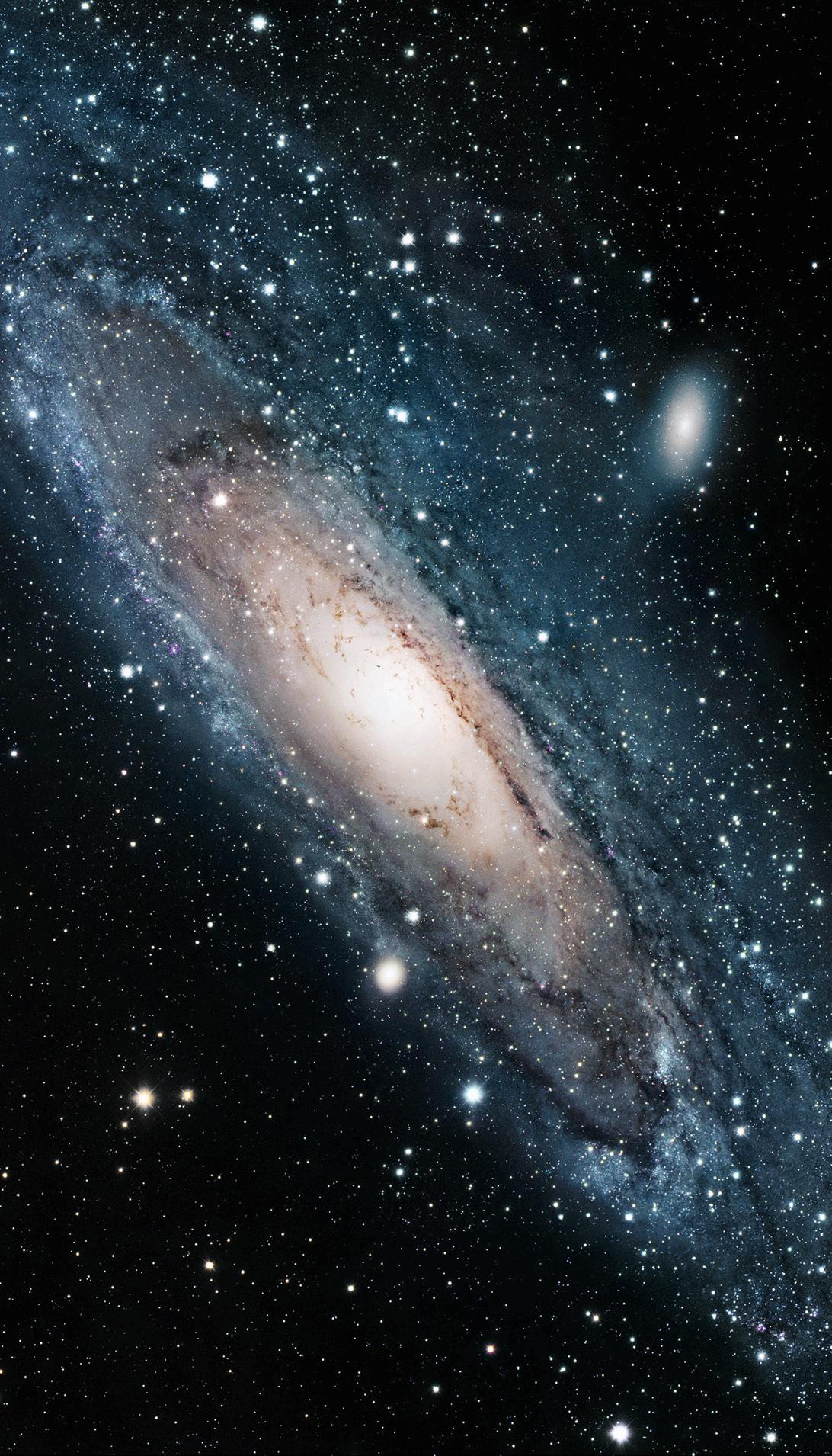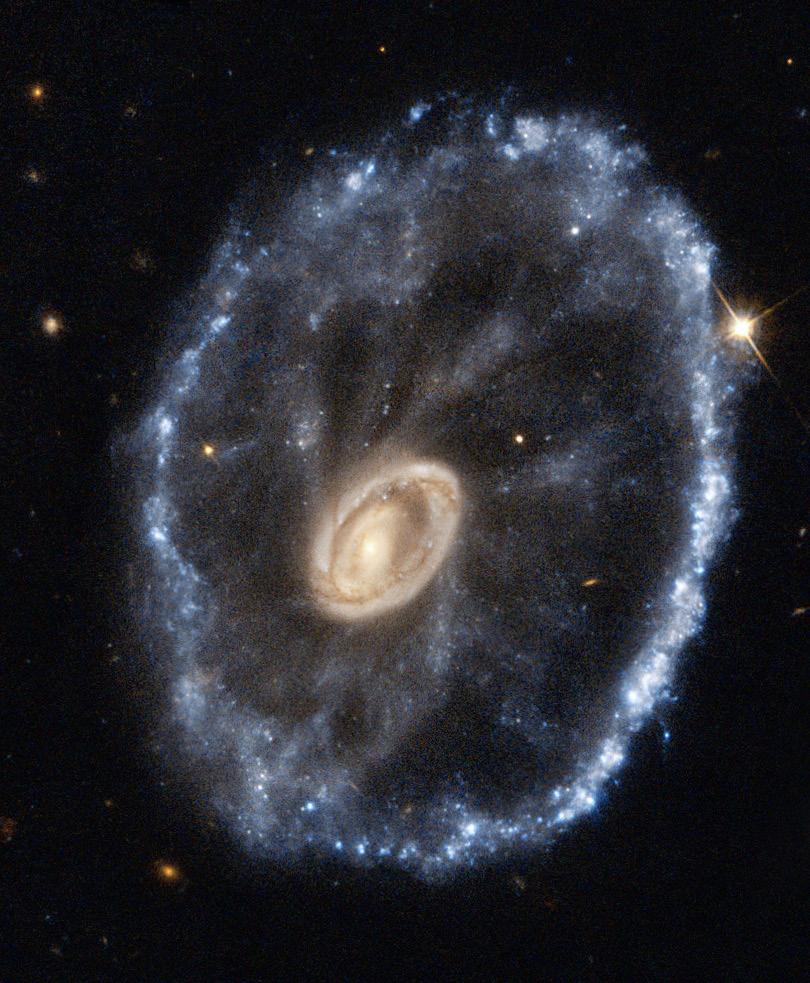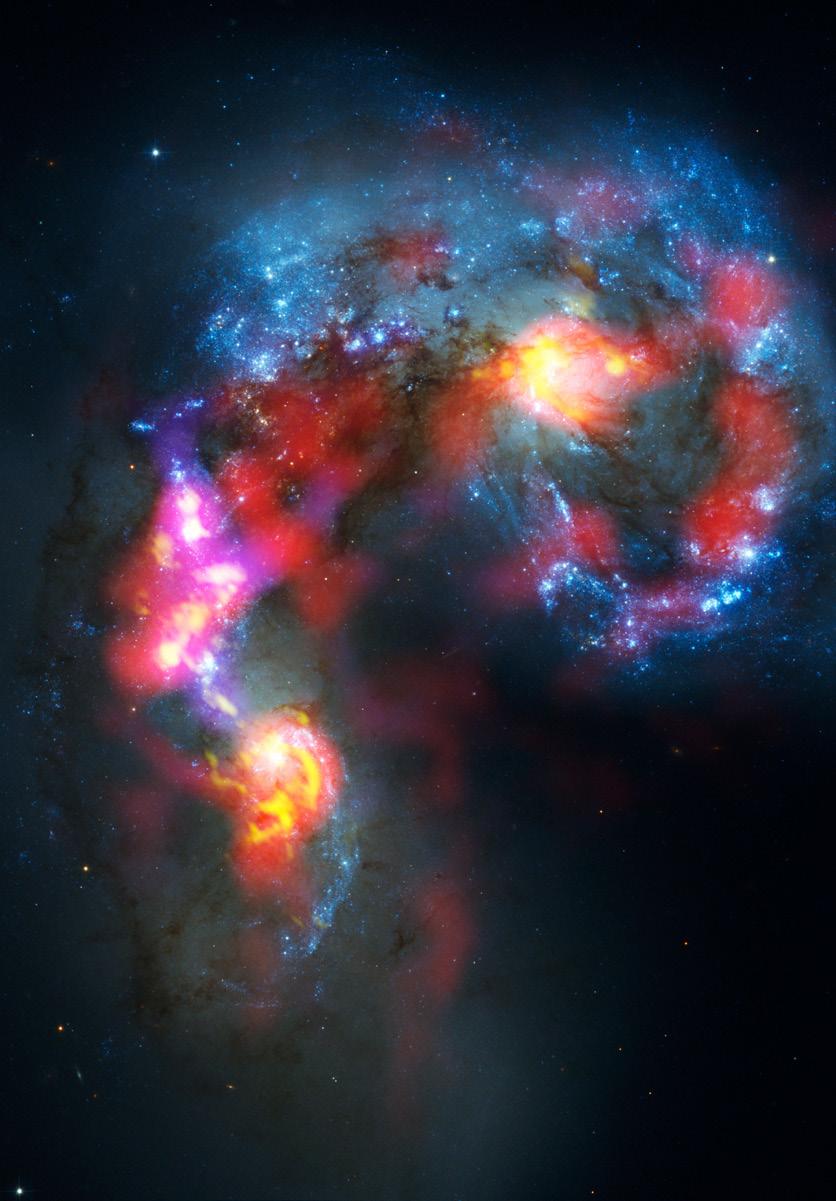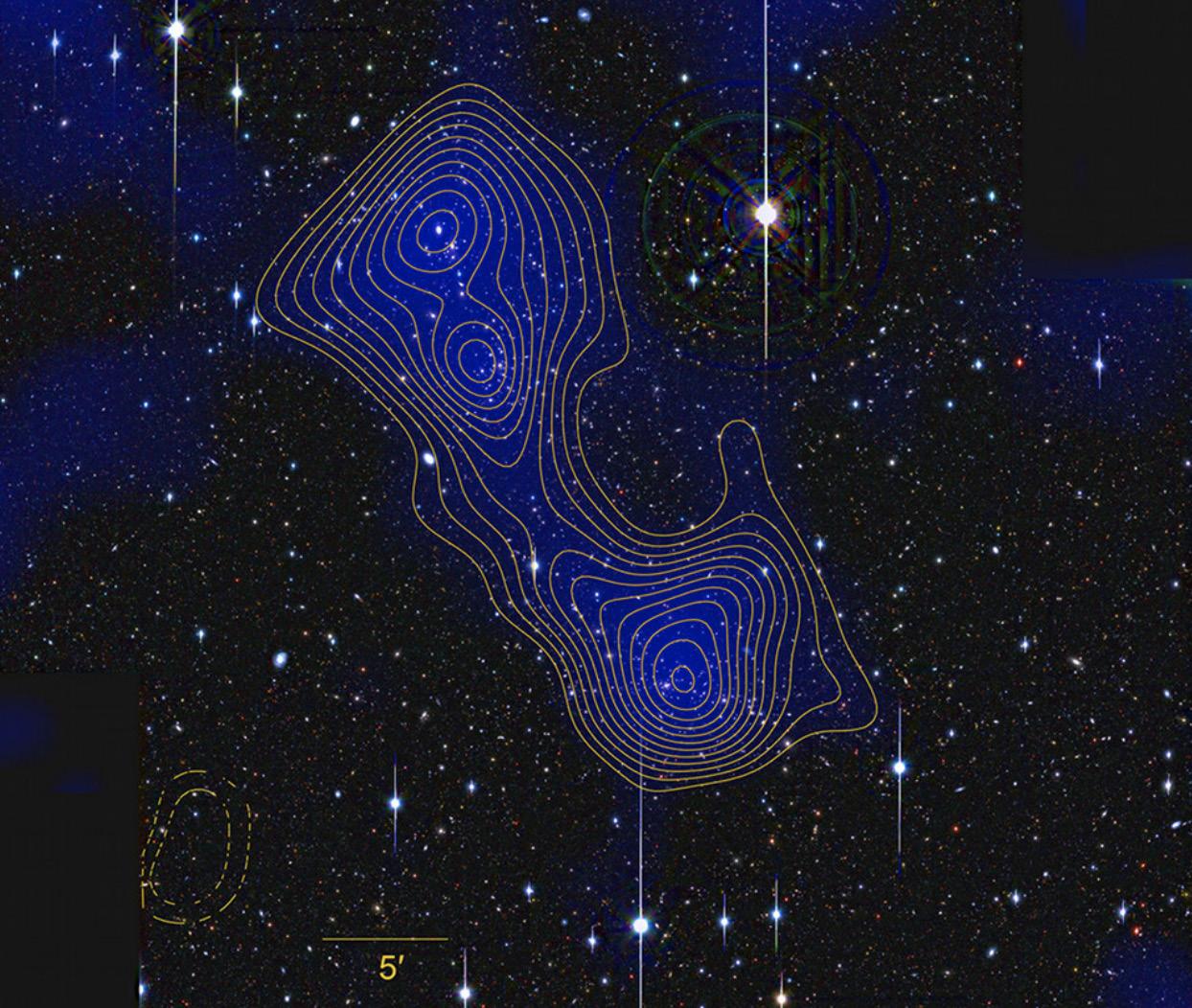
15 minute read
Let’s talk about… galaxy evolution
from Contact 09
The spiral Andromeda galaxy contains hundreds of billions of stars. CREDIT: Robert Gendler/ESA
On 18 December 2021, space watchers will hold their breath for one of the most anticipated launches of recent times, as an Ariane 5 rocket is scheduled to carry the James Webb Space Telescope into space. One of the key goals of this infrared observatory is to study how galaxies form and evolve over billions of years, something the SKA telescopes will study in detail in the radio band. This powerful complementarity promises to give us the best view yet of the processes at work and how they have shaped our Universe.
In the vastness of space, galaxies are the mega structures where stars and planets are created, binding together billions of objects through gravity in one huge and sometimes tumultuous galactic community. Within them, neighbourhoods like our own Solar System are just a tiny part, as becomes obvious to anyone who has seen the plane of our own galaxy, the Milky Way, stretching out across a dark night’s sky.
“One of the things that’s so exciting about studying galaxy evolution is the variety of galaxy shapes and composition; the sheer beauty and intricacy of galaxies when you can study them in detail,” says Dr Mark Sargent, Science Program Manager at the International Space Science Institute in Bern, and co-chair of the SKAO’s Extragalactic Continuum Science Working Group, which studies the structure, formation and evolution of galaxies. “At the same time, despite all this variety, there are underlying regularities in how key galaxy properties correlate with each other; these allow us to infer common patterns in how galaxies formed and evolved.”
Let’s examine that variety first. Astronomers aren’t totally sure what causes galaxies’ different shapes, although it’s likely to depend on their environment – more on that later.
The most common type – almost two-thirds of those we know about – are the eminently photogenic spiral galaxies, looking like giant celestial lollipops with elegant curling arms. The Milky Way and our nearest large neighbour Andromeda are both barred spirals, their arms stretching out from a central luminous bar of stars.
Next we have elliptical galaxies like Messier 87, a name synonymous with the first ever image of a black hole. These galaxies appear like a circle or slightly squashed into an oval shape.
Lenticular galaxies are somewhere between the two types, and include such beauties as the Cartwheel galaxy, imaged by the NASA-ESA Hubble Space Telescope.
Finally we have the complete oddballs, or “irregular” galaxies, such as the Small Magellanic Cloud, visible to the naked eye in the southern hemisphere, which have no consistent shape or structure.
DID YOU KNOW?
For more than a decade, the Galaxy Zoo citizen science project has been asking volunteers to help classify galaxies by their shape, something that the human eye can still do better than computer algorithms. A similar project, Radio Galaxy Zoo, asks citizen scientists to analyse images from the LOFAR telescope, an SKA pathfinder, to identify supermassive black holes and star-forming galaxies, and you can help them too! Find out more: https://www.zooniverse.org/projects/chrismrp/radio-galaxy-zoo-lofar
But what causes them to form in the first place? “Regions of higher-than-average density in the distribution of matter very early in the history of the Universe contract under the force of gravity and begin to form bound structures,” says Mark. “It already is clear that the process can be quite fast in cosmological terms: fairly big objects with the mass of around a billion solar masses have already been detected as far back as just a few hundred million years after the Big Bang.”
Both the SKA telescopes and James Webb Space Telescope (JWST) aim to discover how the very first galaxies formed, during a period known as the Epoch of Reionisation (read about that in the last issue of Contact). But astronomers also want to see how those galaxies evolved over time, a process driven by both internal and external factors.
While we might think of galaxies as luminous – just recall those iconic Hubble images – they are shaped in large part by something that emits no light at all: the enigmatic “dark matter”, which exists both within and around galaxies and has a major impact on their evolution, altering the star formation rates.

The spectacular Cartwheel lenticular galaxy. Its shape is the result of a collision with a smaller galaxy.
CREDIT: ESA/Hubble & NASA
Dark matter makes up around 26% of the Universe, compared to 5% “normal” matter like stars and planets and everything else you can see, but at present hasn’t been detected directly by any kind of telescopes. That means we can only infer its presence from the behaviour of other objects which we can see. Dark matter exists within galaxies and forms huge “halos” surrounding them. These halos are what binds galaxies into clusters; galaxies are rotating so fast that, without the gravitational influence of dark matter holding them together, they would simply break apart. Think of a spinning fairground ride: without a strong restraining force – like a seat restraint or a cable – the centrifugal force would cause people to fly off.
“At a very fundamental level, galaxies as we know them today would not exist without the dark matter ‘scaffolding’ of the cosmic web,” says Mark. “In terms of the total mass, the dark matter component of galaxies is far more important than their luminous (i.e. visible) component. The growth of the dark matter halo of galaxies thus is central to determining the overall gravitational pull a galaxy can exert on material surrounding it, and through this also the rate at which the luminous component grows. At a more detailed level, where a galaxy resides within a dark matter halo (e.g. a central galaxy vs. a satellite galaxy) impacts galaxy properties and their evolutionary path.”
That evolutionary path is closely tied to star formation rates. Galaxies are home to billions, or even trillions of stars – the Milky Way alone is estimated to hold around 100 billion – but star formation is not a constant or steady process. Galaxies that have stopped producing stars are considered “dead”; most ellipticals fall into this category, in contrast to spirals which are active star makers. Our own galaxy is still making new stars, but not as many as earlier in its history.
“Galaxy star-formation histories generally have a ramp-up phase, and then decline again after reaching a peak. Although individual galaxy star-formation histories may fluctuate a lot around this average behaviour, there are some general trends in that the relative duration of the rising and declining phase, and when the peak is reached, depends on the kind of galaxy you are considering,” Mark says. “For instance, galaxies with a high present-day mass will in most cases have experienced peak star-formation earlier than less massive galaxies. Likewise, galaxies which were born in strong overdensities typically have an accelerated evolution compared to galaxies in less dense regions, as it is easier for them to grow.”
Galaxies which are in an extremely active star-making phase are known as starburst galaxies. Star formation is measured in relation to the mass of the Sun (solar mass); the Milky Way converts gas to stars at a rate of a few solar masses per year, but starburst galaxies are far more prolific.
“The strongest starbursts can reach star-formation rates more than 100 times greater than those of ‘normal’ star-forming galaxies. In the local Universe they might reach a star formation rate of several tens or even a few 100 solar masses each year, and at the peak epoch of galaxy assembly even greater than 1,000 solar masses a year,” Mark explains.
So, what causes these peaks in star formation, and why are some galaxies better at making stars than others? The most obvious factor within the galaxy itself is the amount of gas available; stars are born when clouds of gas and dust collapse under gravity, so it stands to reason that galaxies with huge gas reserves are very active in churning out new stars. However, there is also the aspect of how effective galaxies are at utilising their in-situ supply of gas.
“Some of the most star-bursting galaxies appear to be especially efficient in quickly converting their gas reservoir to stars. Such starbursts are often triggered by galaxy interactions or by internal gravitational instabilities, both of which lead to large amounts of gas being compressed into small areas,” Marks notes.
There are a host of processes which can reduce the amount or density of gas in a galaxy, from star formation itself, to the jets and winds being spewed out into the galaxy by an active galactic nucleus (AGN - a black hole consuming material), known as “feedback” - a process that the SKA telescopes will be uniquely suited to observe. Then there’s what’s going on “outside”, in the environment around a galaxy. Mark notes that some of the terminology here is “quite colourful”, and he’s not joking…
For galaxies that exist in clusters, there’s the risk of an unpleasant-sounding process called “ram-pressure stripping”. This happens when galaxies pass through the intra-cluster medium (the environment between the galaxies within a cluster), which we can think of as running through a gauntlet of hot gas. This gas acts like a strong wind, and can actually push gas out of the galaxy.
Tidal effects from other neighbouring bodies, similar to the effect of our Moon on Earth’s oceans, can cause the outer parts of galaxies to become stretched, and therefore less dense, which can negatively affect star formation.
Then there’s “strangulation”, which is less violent than it sounds. Due to their huge mass, galaxies exert a gravitational pull on surrounding material, which means they can draw in (accrete) new gas to keep feeding star formation. If there’s no more gas available: galaxy death by strangulation.
“The time scales on which these processes act can range from tens of millions of years to billions of years. A galaxy really ‘switches off’ if, in addition to all gas being removed or consumed, it is also no longer able to accrete new gas,” Mark says. “We know that accretion rates onto galaxies were significantly larger in the past. That is one of the main reasons why the star formation activity of the Universe as a whole used to be more than an order of magnitude higher than it is nowadays. A significant factor here is the expansion of the Universe, and especially the fact that the expansion is accelerating. The material in between galaxies is thus becoming more and more diffuse, and harder to accrete for galaxies.”
“Importantly, the sensitivity of the SKA telescopes will allow us to study many of these processes in more detail, for example allowing us to map in unprecedented detail the diffuse gas reservoirs around galaxies – from which gas is accreted into the galaxy and can be used to form new stars – through the HI (neutral Hydrogen) emission line. It will also allow us to characterise the sites and effects of AGN and star formation activity in galaxies much better, both for nearby and distant galaxies.”
Radio astronomy is the only way to study these gas reservoirs, as they can’t be seen by optical or infrared telescopes at all, giving the SKA telescopes a unique view.
The same can be said for the effects of magnetism within and between galaxies, which is best studied in the radio spectrum. Magnetic fields of vastly varying strengths are found everywhere in space, including within the giant molecular gas clouds which form stars, and are known to influence the number and size of stars created, as well as possibly even influencing the formation of spiral arms in galaxies. (You can read more about cosmic magnetism, another key area of science for the SKA telescopes, in Contact issue 4).
Galaxies are shaped by their environments, and that can include clashes with neighbours. Galaxy mergers, when two of these giant rotating bodies are drawn together through gravity and collide, is perhaps the most dramatic change a galaxy can experience.

The Antennae galaxies are colliding spiral galaxies about 70 million light-years away, seen here in both radio (in red, pink and yellow) and visible (in blue) light.
CREDIT: ALMA (ESO/NAOJ/ NRAO). Visible light image: NASA/ESA Hubble Space Telescope
Researchers have shown that such mergers account for the fact that there were far more galaxies in the early Universe than we can see today. In 2017 a team estimated that there are two trillion galaxies in the observable Universe and 90% of them haven’t been studied yet, because their light is too faint for current facilities to detect. These early galaxies, made ever more distant by the expansion of the Universe, are what JWST and the SKA telescopes aim to study.
Galaxy mergers can have several implications, chiefly creating a new, larger galaxy. In some, the influx of gas is a catalyst for star formation, but recent studies have found collisions can also push gas out of a merged galaxy, inhibiting star formation in the future. Mergers can also lead to the galaxies’ respective central black holes merging, over the course of billions of years. This causes gravitational waves to ripple out across space, something the SKA telescopes will be able to detect through the precise timing of pulsars (as we explored in Contact issue 5).
A galaxy merger is the fate that will likely meet the Milky Way and Andromeda, which is moving towards us at 400,000km per hour. Happily, that collision is still about four billion years away.
The most effective way to study galaxy evolution is on a grand scale, which is the approach of the Cosmic Evolution Survey (COSMOS), a multi-wavelength survey using both space telescopes and land-based observatories to examine two million galaxies in a patch of the sky known as the COSMOS field. It aims to discover how they evolved by looking back in time into the distant Universe, and by studying their environments. With the advent of JWST, a new survey called COSMOS-Webb will begin.
“COSMOS-Webb will push the story of galaxies back to earlier in the Universe and provide higher resolution images in the near-infrared than we have had before,” says Dr Nick Seymour of Curtin University, a member of the SKA working group who is also part of the 200-strong international team of researchers working on COSMOS. “Through the weak-lensing technique [which measures the total amount of intervening mass present along a given line of sight towards background galaxies] we will be able to measure the distribution of dark matter within the COSMOS field. By supplementing the existing Hubble data, we will be able to trace how the size and shape of galaxies changes over time.
“The number of galaxies well characterised within the first billion years of the Universe is quite small. COSMOS-Webb will give us a much larger sample of galaxies in this important first epoch of galaxy formation. And crucially it will be able to probe even earlier, possibly to just after the first galaxies have formed.
This is a period the SKA telescopes will be able to look back to in the radio part of the spectrum, conducting its own radio continuum surveys which will prove highly complementary to measurements taken by JWST. Astronomers want to study how galaxies developed their stars, and why it is that most galaxies in clusters no longer produce many – or any – with most new stars being formed in isolated galaxies instead.
“We want to trace how galaxies built up their stellar populations as a function of time and environment,” Nick adds. “Deep radio surveys from the SKA telescopes will be able to accurately trace star-formation and active black holes with jets. This will complement the accurate measures of stellar mass at similar resolutions provided by JWST. Having accurate and independent measures of the star formation rate and stellar mass can tell us when and where star formation occurred.”

The orange contour lines on this image represent a filament of dark matter that connects two clusters of galaxies – each containing many thousands of individual galaxies – in the so-called cosmic web.
CREDIT: J.Dietrich et. al (2012); background image taken by the Subaru telescope and obtained from the SMOKA science archive.
As well as directly observing processes in motion, there’s also an important technical angle to this complementarity, which will help both observatories to eliminate instrumental errors which can hamper scientific studies. “Every survey, in every waveband, no matter how careful you are, could be affected by systematic errors due to the instrument and the analysis,” says SKAO Project Scientist Dr Anna Bonaldi. “However, if you rely on the comparison of two independent surveys, for example the SKA telescopes in radio and JWST in infrared, to make your measurements, you effectively exclude those errors. The cross-correlation technique is very popular for cosmological studies, where the survey is used to make precise measurements of the quantities governing the whole Universe.”
Even on their own, the SKA telescopes will reveal much more about how galaxies evolve than we know currently because radio telescopes are uniquely well suited to study many of the factors which are key to galaxy evolution mentioned above, which emit signals at radio wavelengths.
It’s clear, then, that in the coming years the SKA telescopes will be at the forefront of discoveries in this field, and by joining forces with new observatories like the JWST will create the clearest and fullest picture yet of how galaxies form and evolve.
By Cassandra Cavallaro (SKAO)








